When you’re running your online business, you should be constantly on the lookout for new and innovative solutions in your sector. In the world of online software, particularly with SaaS (software as a service) companies, an innovation that is becoming more and more popular is consumption-based pricing.
Also known as usage-based pricing, consumption-based pricing allows you to decide pricing on customer usage. For certain business models, this can be a great way to engage prospective customers with possible savings that reflect their consumption patterns.
In this definitive guide to consumption-based pricing, we’ll explore the meaning of usage-based pricing strategies in depth, examine the upsides of using consumption-based pricing models, and discuss some practical tips for implementing consumption-based pricing in your organization. Read on to find out more!
What is Consumption-Based Pricing?
Let’s say that you’re a small business looking to purchase sales automation software through a SaaS company. In the past, you probably would have selected a pricing tier based on how much you would have expected to use or how many users you need to use the software.
If you find software with a consumption-based pricing model, however, the price that you pay will simply reflect your usage of the software. This means that you’ll only be paying for the amount that you actually use – potentially saving you money.
This sort of payment model has been around for a long time. It’s traditionally been typical for utility companies, for instance, to charge customers according to how much water or electricity they’ve used.
However, consumption-based pricing has only recently started to become widespread in the digital sector. It’s becoming increasingly common in cloud computing, PaaS (platform as a service) and SaaS.
Common Consumption Pricing Models
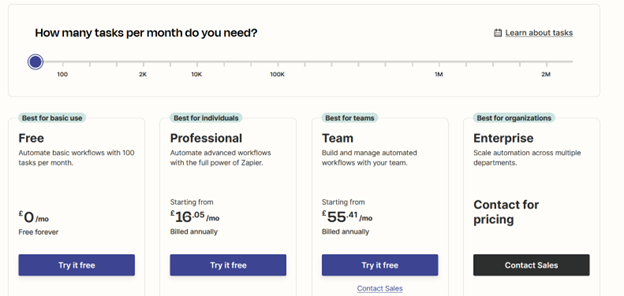
Screenshot taken from zapier.com
While all usage-based pricing models charge customers according to actual customer usage, there are some differences between different types of pricing models. Here are some of the most common consumption-pricing models:
Tiered Usage-Based Pricing
This model retains the tiered approach that has long been widely used by SaaS vendors who use a classic subscription model. However, customers don’t choose the tier that they want to purchase ahead of use.
Instead, each tier has a specific threshold based on usage, for instance the amount of data that has been used. When a customer reaches the threshold, they are automatically entered into the higher tier.
This tiered approach can be a great way to engage new customers. You might want to offer a free lowest tier – new customers will be more likely to sign up for a free option, while the pricing model has a built-in method for quickly increasing revenue as these customers continue to use your service.
Per-unit Pricing
This is probably the most simple and straightforward form of consumption-based pricing. It measures the number of units that customers use – the form that the units take will depend on the product but is commonly a volume of data or hours used.
Once the number of units has been calculated, customers are then charged for the specific number of units that they have used over a set amount of billing periods. Unlike a tiered approach, this is solely a usage-based pricing strategy which allows customers to only pay for their usage.
Hybrid Pricing
Some companies might find the transition from subscription-based pricing to consumption-based pricing a big leap. In these situations, a hybrid pricing model might be useful. This is a more flexible approach that allows you to create a specific pricing model that is well-suited to your company’s context.
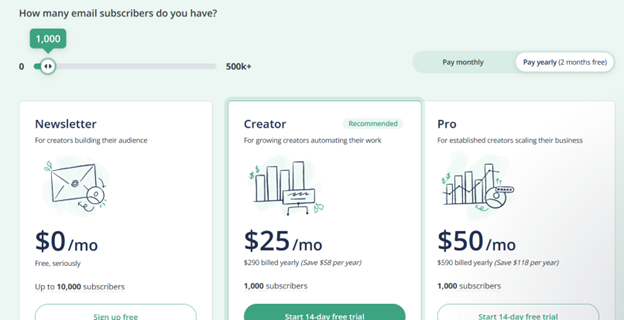
Screenshot taken from convertkit.com
Although a hybrid pricing model can take a variety of forms, it might include using consumption-based pricing for certain elements in your product while also having a baseline subscription fee. This can make usage-based pricing work for your requirements, but it is inevitably more complicated than a simple consumption-based pricing model.
Benefits of Consumption-Based Pricing
Now that you know more about consumption-based pricing and the different forms that it can take, you might be wondering why you should bother using it in your company. After all, moving to a different pricing strategy can take a lot of time and effort, often requiring new systems for online payments and usage monitoring.
However, usage-based pricing has a range of huge benefits for your company and your customers. Here are the biggest advantages of consumption-based pricing:
- Easier customer adoption. With usage-based pricing, new customers will have fewer upfront expenses. They don’t have to worry about being tied into a long-term commitment, while they also can try out a service for little cost. This will help you through the process of product adoption with prospective customers.
- More satisfied customers. When customers are just paying for their actual usage, they often feel that they are getting more value for money and don’t worry about failing to get the most out of a subscription. This will boost customer satisfaction, boosting customer loyalty, and revenue retention over the long term.
- Revenue data. Consumption-based pricing means that your revenue will match closely with actual usage. This means that you don’t have to worry about customers failing to resubscribe and that you can budget for the future more easily. It can also be used with sales intelligence tools to know the products that are used most widely.
- Flexibility. If you use a consumption-based pricing strategy, you aren’t locked into long-term subscriptions with your customers. This gives you greater flexibility, meaning that you can quickly respond to market trends and effectively react to changes in customer demand.
How to Use Consumption-Based Pricing: Practical Strategies
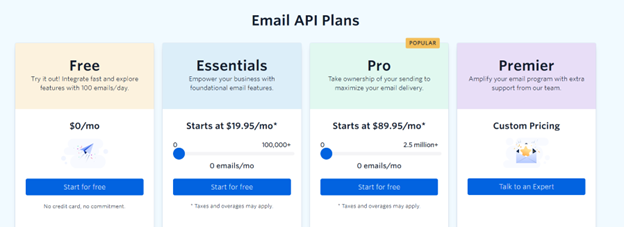
Screenshot taken from sendgrid.com
The advantages of usage-based pricing mean that more and more companies are starting to adopt this pricing model in their day-to-day operations. But how can you use consumption-based pricing as a practical strategy in your business? Here are some top tips for moving to consumption-based pricing:
1. Conduct Market Research
Before you start to implement consumption-based pricing, you need to be as informed as possible about how receptive your customers would be to a new pricing model, as well as how common usage-based pricing is within your sector. Research your competitors’ pricing models and look for any evolution in software pricing across the sector.
You should also gather feedback from your users, such as by using surveys or questionnaires. You could ask about opinions around recurring billing or subscription options, for instance. This data could be collected in a usage-based pricing report that weighs up the pros and cons of changing pricing models for your company.
2. Identify Your Usage Metrics
If you decide to use consumption-based pricing, you’ll need to know which metrics you’ll be using to build your pricing plans. This metric needs to be closely linked to the value that customers find in your service – this will mean that costs will come to be associated with positive outcomes for your customers. It will entirely depend on your business context.
3. Consider Pricing Models
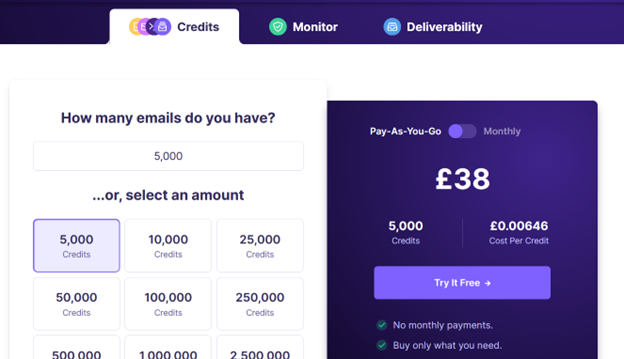
Screenshot taken from emailable.com
You’ll also need to figure out which specific type of consumption-based pricing you’ll want to use. If you are a fairly small company looking to quickly scale up with lots of new customers, a tiered approach could be useful. This is because you could offer an eye-catching, low-cost, or free initial tier that will attract new users.
Alternatively, you might just want to use a simple per unit pricing plan. Let’s say that your company offers a PBX phone system as a software. You might choose to charge customers according to how many users they have over a billing period, as this will allow your users’ costs to reflect their business size.
4. Communicate with Existing Customers and Prospective Customers
Regardless of the specific features of your consumption pricing model, it’s crucial that your customers are able to prepare for the transition and see the benefits of the new pricing strategy.
You should communicate with your existing customers about any impending changes – this could be accompanied by a pricing calculator that will allow customers to see if they will save money through the new pricing model. It should also include a clear list of advantages to usage-based pricing. You also make this clear to potential customers on the product page.
5. Track and Monitor Key Metrics
Once you have moved to a consumption-based pricing model, you’ll need to be constantly tracking and monitoring key metrics to see how it is benefiting your company. You could segment your audience to analyze the impact of usage-based pricing across your customer base.
This will allow you to recognize any weaknesses in your pricing model, such as whether you have chosen the most appropriate metric on which you base your pricing. As well as this, staying on top of key metrics will mean that you can adjust your pricing accurately when you introduce new products or update it with new features.
Consumption-Based Pricing: The Future of SaaS
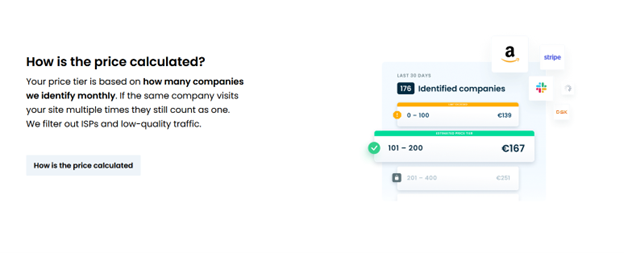
Screenshot taken from leadfeeder.com
As more companies, especially in the world of SaaS, are moving towards consumption-based pricing models, you need to be able to see how it benefits companies and customers alike. With higher levels of flexibility and easier levels of customer adoption – as well as a range of different models within usage-based pricing – the advantages are obvious.
That’s why we put together this practical guide to consumption-based pricing, especially our practical tips that help you to implement usage-based pricing in your organization. So, what are you waiting for? Start using consumption-based pricing today!
About Author
Lucas Rossi – Growth Marketing Manager
Lucas Rossi is a Growth Marketing Manager at Dealfront, the go-to platform for giving sales and marketing teams the data to close deals in Europe. Lucas plays a key role in refining Dealfront’s data-driven approach to decision-making, leading to better lead quality and sales results. Lucas’ approach has advanced Dealfront’s marketing position and put it at the forefront of growth marketing.





